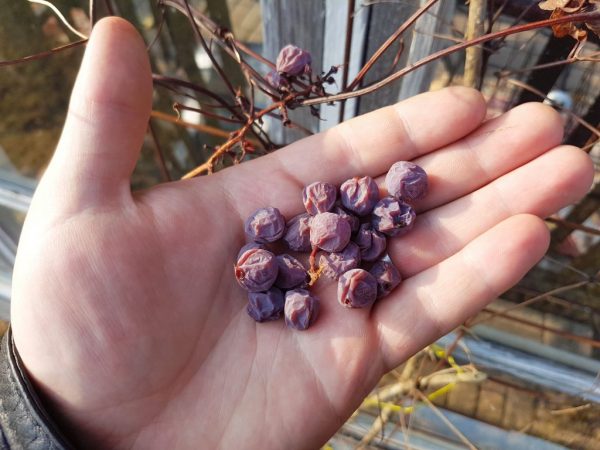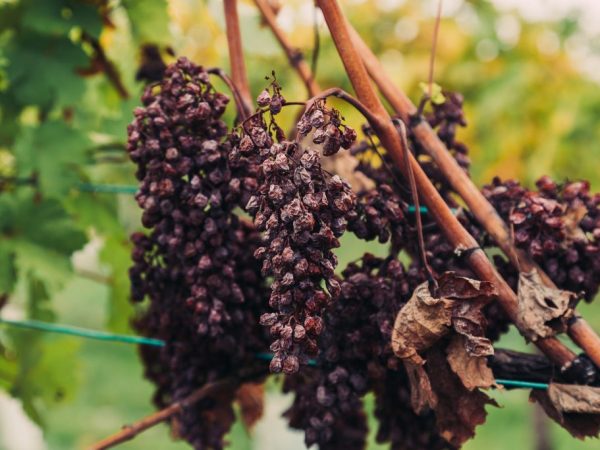Grapes dry berries and wither brushes
Grapes dry and wither for a number of reasons. Their identification and elimination allows you to return the yield to the proper level.

Grapes dry berries and wither brushes
Drying reasons
Choosing a variety for growing, based on its parameters:
- the timing of fruit ripening;
- resistance to disease and cold;
- growing region.
The wrong selection of varieties often leads to health problems of the vine.
Sometimes the brushes dry out, the berries dry on the grapes and crumble. The most common cause of the problem is fungal disease.
Berries can wilt in varieties with a large bunch, but a weak peduncle. The stalk bends, food stops flowing into the bunch, due to this, the grapes dry out. In such cases, the vines are placed on arches and supports.
The reasons why the leaves and berries of grapes dry also include agrotechnical:
- a small amount of top dressing and fertilizers;
- drought;
- leaf and fruit burns;
- little or no treatment for diseases;
- improper tying of the bush to the support, especially varieties with large fruits;
- poor quality vine pruning or lack of it.
Fungal diseases
The grapes dry out at different points of ripening: both after they are tied, and in the process of ripening the fruits. If the wilting of the berries is combined with other symptoms, for example, the foliage is covered with spots, the problem is in one of the diseases: mildew, eutiposis, anthracnose, verticillium, buibol leafhopper.
If the bush begins to hurt, treatment is best done before winter: this way there are more chances to save the bush. As a preventive measure, 2 treatments of the bush are carried out per season: this reduces the risk of ailments.
Mildew
The berries on the grapes wither because of the mildew. The disease spreads quickly, so treatment is needed for all healthy vines. In another way, the disease is called downy mildew. The disease affects the brushes, ridges, berries, leaves, perennial and young shoots.
If the bush has not been processed and the fungus has penetrated into the fibers of the bush, nutrition, the flow of moisture is upset, the berries dry on the grapes, and then die off.
Eutiposis

Disease can kill an entire crop
In the people, eutiposis is called dry-handedness in another way.
The wood of the vine suffers from the disease, which slows down the growth and development of shoots, leaves, berries. The berries that have set are small, the leaves are unhealthy, covered with spots, the shoots are short and infantile. The fruits stop in development, in growth and finally dry up.
Anthracnose
Anthracnose is a fungal infection of grapes. The fungus develops in high humidity. During the period of illness, the bush becomes covered with spots on the leaves, brushes. If the disease is detected before blooming, the entire brush is destroyed, and the grapes dries.
Verticillosis
Verticillosis is a fungal infection that enters the bush through the root system.
The disease manifests itself several years after the defeat. Young shoots get sick due to a violation of moisture intake. If the bush waddles heavily, the disease manifests itself more actively.
Defeat is possible due to lack of watering and drought.
During the course of the disease, the foliage dries up and withers, as with a sunburn. In the future, shoots and bunches dry out, the nutrition of unripe berries is disrupted. Bunches of grapes dry out, especially the lower rows, individual berries from a bunch die off. The brush looks unattractive, consists of lethargic and shriveled berries, loses its presentation.
Pests
Another reason why the brushes dry on the grapes is the appearance of the buffalo leafhopper.
This insect gives birth once a season, the cicada larvae grow in the grass under the grapes, then the adult pest crawls up onto the bush.
Prevention of buffalo leafhoppers - two-time treatment with benzophosphate and frequent weeding at the roots of the plant. Buffalo leafhopper spoils shoots and ridges. Due to ring damage, water flow is disrupted and the grower sees that his crop has dried up. Onions and garlic, planted near the roots of the grapes, scare the insect.
Conclusion
If the grapes begin to dry rapidly or have completely dried up, they carry out all the proper agrotechnical and therapeutic measures, determine the cause, and correct agrotechnical mistakes.


